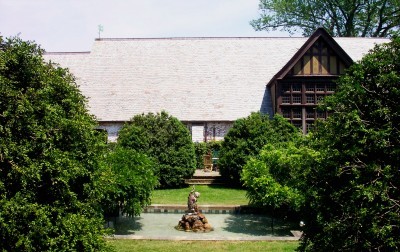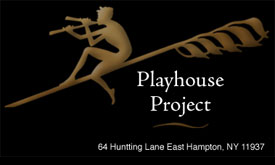And Then the Fidgeting Stopped
By Thomas Bohlert October 27, 2009
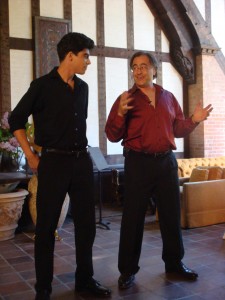 I am sure it wasn’t my imagination. On each side of me were two elementary-school-age boys, fidgeting throughout the beginning of the program with their digital cameras, which emitted the obligatory beeps, bloops, brittle chimes, and thin-sounding bits of melody, as Geoffrey Simon rehearsed the 90 or so musicians in Mozart’s “Ave Verum.”
I am sure it wasn’t my imagination. On each side of me were two elementary-school-age boys, fidgeting throughout the beginning of the program with their digital cameras, which emitted the obligatory beeps, bloops, brittle chimes, and thin-sounding bits of melody, as Geoffrey Simon rehearsed the 90 or so musicians in Mozart’s “Ave Verum.”
Gradually their restlessness settled down, and they were drawn in to not only the sublime music filling the room but, I am certain, the process of music making. Before very long, the cameras were nearly forgotten, and their faces seemed entranced by the sounds of the voices and strings.
On Saturday, once again, the Playhouse Project brought Mr. Simon, an Australian conductor who resides in London, to East Hampton to work with students, adults, amateurs, and professionals in an evening and afternoon of intensive rehearsals, followed by an open workshop for the public.
Mr. Simon has been the director of the Sacramento Symphony, the Northwest Mahler Orchestra in Seattle, and the Orquestra Simfonica de Balears in Mallorca, Spain, and has his own recording label, Cala Records.
The weekend was sponsored by the project and the Swiss Global Artistic Foundation, of which Mr. Simon is the artistic director, and it was free for the participants and the audience.
There were musicians from Hampton Bays High School, Southampton High School, Our Lady of the Hamptons in Southampton, the Ross School in East Hampton, Pierson High School in Sag Harbor, the East Hampton Middle and High Schools, and from the Choral Society of the Hamptons. There were also a number of other singers and a handful of professional string players to round out the ensemble.
The ensemble was pretty well balanced, except for violas. As it turned out, because of sickness and no-shows, there was only one violist, actually a professional violinist, who held her own just fine against the other sections.
The audience filled the Elizabethan-style Brockman Playhouse, sitting on sofas and chairs, on the benches of the banquet table leaning against the brick wall, in the organ loft, and some in the alcove right behind the conductor, with the fireplace behind them lit.
Especially interesting was the format of the open workshop, rather than a typical concert, in which the audience could experience the demanding procedure of rehearsing as the last touches were put on each piece before a final “performance.”
Mr. Simon is unusually adept at meeting the musicians where they are and charming, cajoling, and coaxing them to new heights of artistry. Two of his main principles were the accompanying role of the orchestra — reminding the players to not overpower the chorus when they were singing, and to let their sound blossom in the interludes — and a “spinning” sound for the choir, in which the voice floats and soars with the musical phrase.
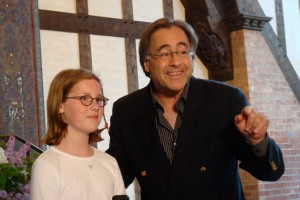 “Infuse it with intensity and line,” Mr. Simon told the singers; and later he critiqued the string players: “You barreled on through” the break. After some time of rehearsing, he announced the performance of the piece. Not only was it wonderful, but the listener was all the more involved in those subtle details that lift the music out of the ordinary and into the exquisite.
“Infuse it with intensity and line,” Mr. Simon told the singers; and later he critiqued the string players: “You barreled on through” the break. After some time of rehearsing, he announced the performance of the piece. Not only was it wonderful, but the listener was all the more involved in those subtle details that lift the music out of the ordinary and into the exquisite.
Gabriel Fauré’s “Cantique de Jean Racine,” named after the dramatist who paraphrased the Latin text in French, was next. In both the “Ave Verum” and the “Cantique,” nothing was said about the texts, hardly even a mention that one was in Latin and one in French, other than that the Fauré had a devotional text. That was too bad; I think the audience might have been enlightened by some points about how the music related to certain words or phrases. Nonetheless, one was certainly able to understand the musical essence — mood, emotion, form, texture, architecture — and even more so after hearing the rehearsal process.
The “Cantique” is a lyrical, prayerful piece, and perhaps the hardest things for the younger players were the slow, sustained line, and the give and take of the tempo. The final straight-through rendition soared, and settled on the softest and most angelic sounds.
One couldn’t help but notice the outstanding acoustics of the Playhouse. Because of the room’s design and construction materials, the blend of voices and instruments was clear and even from almost anywhere. Not to get too far off subject, but there are lessons in natural acoustics from such rooms, this one built 1917, which many of us would do well to study today.
After a break there were two more pieces by the string players alone. First was the opening movement of Bach’s Brandenburg Concerto No. 3 in G, which had been rehearsed quite a bit beforehand, and with only a short warm- up to secure the rhythms, it got a lively and energetic reading. It was a good contrast to the earlier works and drew perhaps the biggest applause.
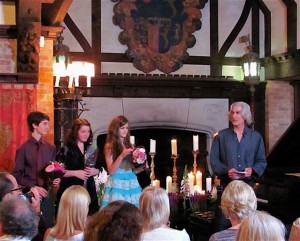 If the first three selections were challenges to the players, Samuel Barber’s “Adagio for Strings” was an even bigger one. There were not only the technical demands but the emotional maturity needed to play it well. In one place, the cellists were having quite some difficulty finding a particular note. “No guessing. Find the G flat,” said Mr. Simon. They tried. “Ouch!” With guidance and insistence, they tried again. Finally they got it, or quite close to it. Ever optimistic and encouraging, the director said, “Our ears demand from us that we settle for nothing less than that degree of perfection.” Even in the rehearsal, the audience oohed at the beauty of the ending section of the Adagio. In the performance, the players reached well beyond their ability in this profoundly beautiful music.
If the first three selections were challenges to the players, Samuel Barber’s “Adagio for Strings” was an even bigger one. There were not only the technical demands but the emotional maturity needed to play it well. In one place, the cellists were having quite some difficulty finding a particular note. “No guessing. Find the G flat,” said Mr. Simon. They tried. “Ouch!” With guidance and insistence, they tried again. Finally they got it, or quite close to it. Ever optimistic and encouraging, the director said, “Our ears demand from us that we settle for nothing less than that degree of perfection.” Even in the rehearsal, the audience oohed at the beauty of the ending section of the Adagio. In the performance, the players reached well beyond their ability in this profoundly beautiful music.
And this is the essence of the Playhouse Project. Richard Brockman and Mirra Bank founded it to restore the playhouse to its original function, Mr. Brockman said, as a place for arts education, for bringing together the “young, middle, and older” in musical opportunities for the community outside of the summer season. What better example of achieving that goal can be cited than the boys’ attention being drawn away from their cameras?
Mr. Brockman had said earlier in his welcome that these events have “at times shaken my soul.” Indeed, this one shook mine.
